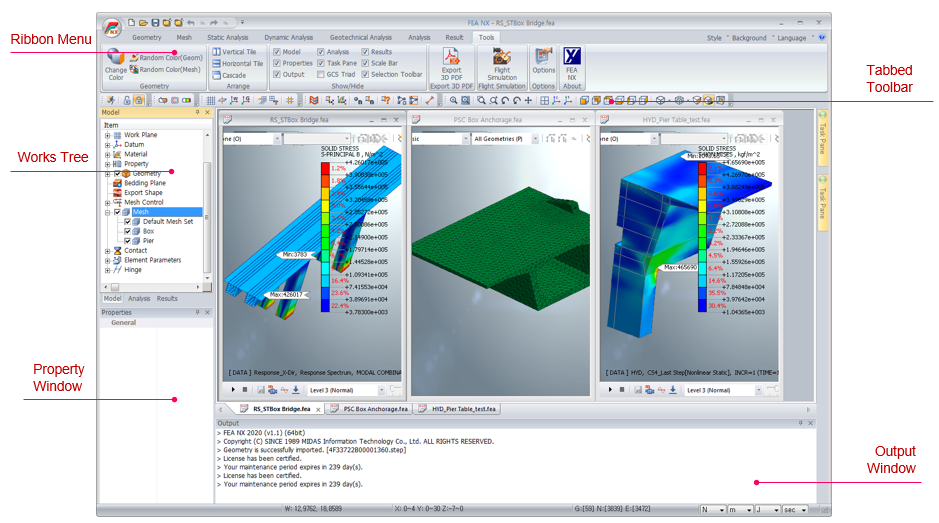About FEA NX
FEA NX is state of the art software which defines a new paradigm for advanced nonlinear and detail analysis for civil and structural engineering applications. It is specialized for refined method analysis, which is required by design codes for complex geometry. FEA NX's unique capabilities make it possible to efficiently model complex structures with shell and solid elements instead of using 1D elements to simplify your model. Thus you will be able to perform local analysis for elements and obtain in-depth and highly accurate calculations that are essential for projects that require refined method analyses.
FEA NX is also a simulation program developed for the evaluation of soil-structure interaction based on the finite element method. FEA NX helps engineers to perform step-by-step analysis of excavation, banking, structure placement, loading and other factors that directly affect design and construction. The program supports various conditions (soil characteristics, water level etc.) and analytical methodologies to simulate real phenomena.
Settings for all types of field conditions can be simulated using non-linear analysis methods (such as linear/non-linear static analysis, linear/non-linear dynamic analysis, seepage and consolidation analysis, slope safety analysis) and various coupled analysis (such as seepage-stress, stress-slope, seepage-slope and nonlinear dynamic-slope coupled analysis).
The interface of FEA NX provides easy modeling and analysis tools, creating an intuitive working environment for general and novice designers. The 64-bit OS supported next-generation platform base and new graphic engine allows the best modeling performance for object calculation and element generation, while the 64-bit integrated solver considerably reduces the analysis time for large models.
<FEA NX Framework>
This manual gives detailed instructions for each menu function in FEA NX.
All functions are arranged in order of modeling, analysis setting, result analysis and output process for each analysis method and helpful tips are included. The function descriptions and tips can also be accessed through the online manual (F1 key) within the program.
The contents of each chapter are as follows.
Chapter1. Introduction
This chapter gives the program outline and manual composition.
Chapter 2. General Information
This chapter explains the basic menu and various tools for starting the program. Details on the toolbar for task screen settings and the tools required for program operation, such as view/selection/model guide, are included. Complete understanding of the modeling and result confirmation functions is required before learning about the main menu and other functions.
Chapter 3. Geometry
This chapter explains the functions for geometric shape (line, surface, solid) creation and modification, i.e. the first step of modeling. Explanations are given for the calculating functions that are necessary to complete the geometry by modifying/editing shapes created on other CAD-based programs. There is also a feature that can search and correct shape errors automatically.
Chapter 4. Mesh
This chapter explains the functions for creating and editing elements based on their geometric shape. A detailed description of the behavioral characteristics and material parameters assigned to an element (ground/structure) that affects the analysis is included. This step is the most important modeling step and hence, it is necessary to understand the sections on element quality and material properties of the soil/structure. More details on soil/structure material properties can be found in the ‘Material’ section of the ‘Analysis’ manual.
Chapter 5. Analysis method
This chapter explains the functions for setting boundary and load conditions during the final stage of modeling. Construction stage setting functions for step-by-step interpretation of the construction process is also included. Setting of boundary and load conditions corresponding to the analysis type is vital for correct result analysis.
Chapter 6. Analysis
This chapter explains the important options for controlling analysis method as per real phenomenon after the modeling is completed. Analysis conditions and controlling options have a significant impact on the results. Options and their impact on results for each analysis method are described in detail. The detailed algorithm for each analysis method can be found in the ‘Algorithm’ section of the ‘Analysis’ manual.
Chapter 7. Result & Tools
The interpretation and extraction of results are as important as the actual analysis process. Efficient checking of outputs for design applications are described in detail.
